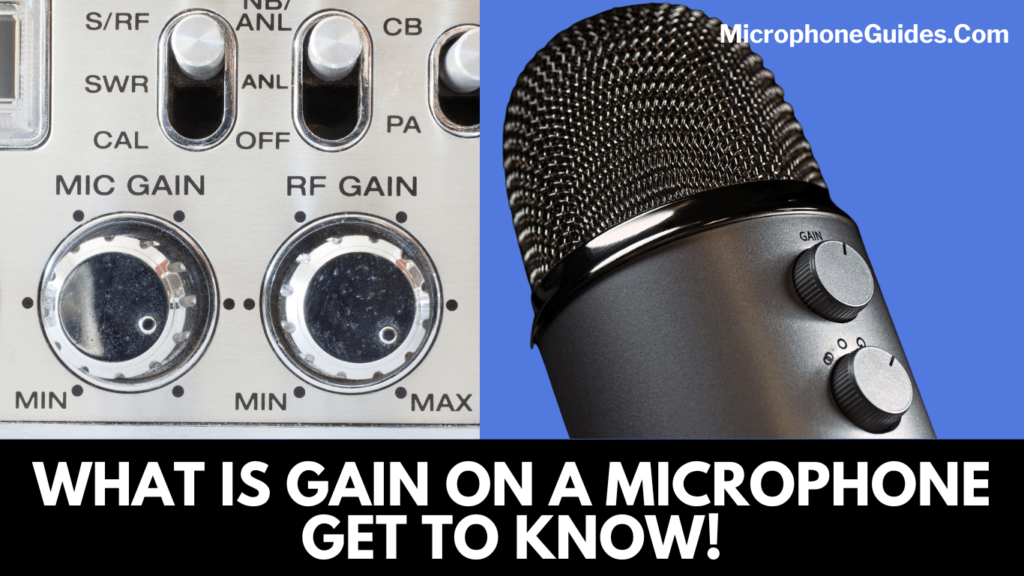You might be wondering what is gain on a microphone. Here we are going to give you a complete understanding of this concept. First of all, you must not mix volume and gain purpose. These terms should not be used interchangeably though both are meant to generate louder output.

The knobs located on the audio interface usually have gain and volume controls. If you increase the gain, the microphone will produce a louder output. Below you can read out more of the details:
Basic information on Microphone Gain
We all are aware of the fact that increasing volume increases and quickly augments the loudness of sound. The exact purpose is somewhat fulfilled by gain. Volume changes the signal strength, but gain not only alters the signal strength. It also strengthens the tone and overall loudness. Gain has been defined as the input dB. It places a noticeable impact on each characteristic of a sound.
Giving you more of an exact idea! If you maximize the gain on a guitar amp, this entire processing overdrives the amp, making it difficult for you to handle the audio signals. In addition, the audio quality will become distorted.
How gain affects or puts impact recording volume?
It entirely depends on the audio device processing regarding how gain will impact it. If we specifically talk about a microphone, you must assume that here gain is described in the form of sensitivity. The general rule is that increasing the gain will boost the microphone’s sensitivity.
The higher the gain, will push the mic picks up and quickly collect the quieter sounds. Reducing the microphone’s gain, the input signals accessing your mic preamp will become weaker. And ultimately, the output will fail to be generated on a louder scale. Thus, altering the gain does have a significant impact on the recording volume.
How to make the best use of gain and volume?
Remember that gain is defined as the input signal strength, while volume is explained as the output signal strength. You must use both of these parameters smartly and effectively. Changing gain will have a direct impact on the microphone’s volume. If you set the settings correctly, the sound produced by a mic will come out rich and crisp. Gain adds energy and strength to the signals.
How does the Microphone Gain affect signals?
As mentioned above, the gain amplifies the mic signals right to the line level. You can only strengthen the signal range if you meet specific criteria.
The sensitivity of the mic determines how the microphone gain will affect signals. Active mics, which include condenser mics, are packed with built-in amplifiers. These mics remain to be more sensitive as compared to passive mics. Note that a condenser mic needs less preamp gain as compared to a dynamic mic. The less preamp gain will help it achieve and acquire maximum line-level signal strength.
On the other hand, the proximity and loudness of the sound source determine how the gain will eventually affect signals. If you place a microphone very close to a kick drum, it will ultimately need less gain compared to the microphone placed further away from the kick drum.
How to adjust the microphone gain?
Adjusting the mic gain is no longer a complex task. The only thing to make sure of is not to overdrive the signal. The audio source, like mixers, will show a red light if you overdrive the signals. Adjust the gain in a way that amplifies the signal strength without delay.
If you notice that the record levels have become too low, then it is recommended to turn up the microphone gain. And in case the levels turn out to be too high, then it seems advisable to turn down the gain. Hence, adjust the gain until and unless the mic produces the loudest sound in a waveform!
The minute you plug a microphone into a preamp, the individual witnesses a gain control adjustment. You can control the gain with the help of a knob. Turning the knob clockwise increases and boosts the gain. If you turn the knob anti-clockwise, the gain will get decreased. It is in dB values that will get the readings.
When you notice that you have adjusted and set the gain correctly, you are ready to use and control the audio signals via the channel strip. Thus, the ultimate purpose of the gain adjustment is to make the instrument and microphone get in sync. Both the mic and instrument can have equal signal strength if you have adjusted the gain correctly. Equal signal strength means the gain and volume controls are crafted at the proper balance.
Conclusion
That is about the end of the discussion on what is gain on a microphone! Remember that gain adjustment should be your priority. It comes first, and volume adjustment comes second when using a microphone. Microphone gain boosts the amplitude of a mic signal and increases the signal strength.
The golden rule of thumb, which you must never forget, is that the higher the gain, eventually and ultimately, the louder the output and signal strength will be. If you suspect your microphone is showing low sensitivity, you must immediately turn up the gain. In doing so, the amplifier can produce the sound louder and more clearly.
Moreover, your mic volume does not control the tone. In fact, it is the gain that controls and balances the tone. You can further share your queries and ambiguities with us on this webpage. We will guide you extensively, and do not forget to stay tuned and in touch with us.
William Souza Here, I Am Sound Specialist, Have Trained Many Musicians And Singers. I Write Blog Contents About Sound, Music, Microphone Reviews, Speaker Reviews, Sound Card Reviews And All About Sound/Music Reviews And Instruction. I Am Writing On This Blog MicrophoneGuides.com As On My Experience And Will Update More Information & Review About Different Microphones For Different Users.









